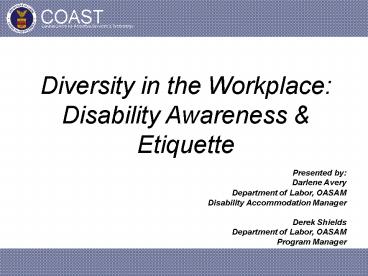Diversity in the Workplace: Disability Awareness - PowerPoint PPT Presentation
Title:
Diversity in the Workplace: Disability Awareness
Description:
People depend on their arms for balance, consider equipment part of their ... Treat people as you would want to be treated with dignity, respect and courtesy ... – PowerPoint PPT presentation
Number of Views:993
Avg rating:3.0/5.0
Title: Diversity in the Workplace: Disability Awareness
1
Diversity in the Workplace Disability Awareness
Etiquette
Presented by
Darlene Avery Department of
Labor, OASAM Disability Accommodation
Manager Derek Shields Department of Labor,
OASAM Program Manager
2
Definitions
- A disability is a condition caused by an
accident, trauma, genetics or disease which may
limit a persons mobility, hearing, vision,
speech or mental function - A handicap is a physical or attitudinal
constraint that is imposed upon a person,
regardless of whether that person has a disability
3
Disability Laws
- Rehabilitation Act 1973
4
Disability Laws
- Americans with Disabilities Act 1990
5
People with Disabilities
Michael J. Fox, Marlee Matlin, Stevie Wonder
James Earl Jones Robert David Hall
6
Communicating with People with Disabilities
- Say
- Person with a disability
- Person with a physical disability
- Person who is blind
- Person who is hard of hearing
- Person who communicates differently
- Person with a psychiatric disability
- Dont Say
- Handicapped
- Crippled, lame
- The blind
- Suffers from a hearing loss
- Mute
- Nuts, crazy
7
Interacting with People with Disabilities
- Top 5 Things to Consider
- Ask before you help
- People desire to be independent and treated with
respect - Be sensitive about physical contact
- People depend on their arms for balance, consider
equipment part of their personal space - Think before you speak
- Speak directly to the person
- Dont make assumptions
- People are the best judge of what they can or
cannot do - Respond graciously to requests
- An accommodation is not a complaint
8
Exercise 1
9
People with Dexterity/Mobility Disabilities
- Place yourself at eye level when communicating
- Do not lean on their wheelchair or assistive
device or ask them to hold items (coat, umbrella,
etc.) - Dont push or touch their wheelchair (personal
space) - Keep ramps and wheelchair accessible doors
unlocked and unblocked - Dont grab the arm of someone using canes or
crutches (lose balance)
10
Assistive Technology Solutions
- Dexterity/Mobility Disabilities
- Alternative keyboards pointing devices
- Keyboard enhancement systems
- Speech recognition software and training
- Ergonomic chairs
- Back rests and foot rests
11
Exercise 2
12
People who are Blind/Low Vision
- Identify yourself before making physical contact
(entering and leaving a room) - Provide a tour of a new facility (new employee)
- Describe setting, environment, obstacles when en
route - Dont grab their arm to guide them
- Offer your arm or shoulder if they need guidance
- Dont pet their guide dog without asking them
first - Offer to read information
13
Assistive Technology Solutions
- Blind/Low Vision Disabilities
- Screen reader software
- Magnification software
- Closed circuit television
- Scanner/readers
- Portable notetakers
- Braille displays
- Braille embossers
14
Exercise 3
15
People who are Deaf or Hard of Hearing
- Utilize a sign language interpreter or write
things down - Look directly at the person not the interpreter
- Do not obstruct view of mouth when speaking
- Speak clearly and at a normal pace
- Recognize the use of assistive listening devices
- Do not shout or exaggerate speech
16
Assistive Technology Solutions
- Deaf/Hard of Hearing Disabilities
- Interpreting services
- Assistive listening devices
- Personal amplification devices
- TTY phones
- Signaling devices
- Captioning services
- Blackberrys
17
People with Learning (Cognitive) Disabilities
- Offer to be in a quiet or private location
- Give verbal explanations
- Speak clearly
- Allow adequate time for actions (reading,
writing, speaking) - Ask if they need clarification or have questions
- Provide alternative ways of communicating the
message (demonstrations, in writing) - Be patient, flexible and supportive
18
People with Speech Disabilities
- Give person full attention
- Dont interrupt or finish sentences
- Ask for clarification if person is misunderstood
- Repeat them for verification
- Ask them to write it down
- Move to a quieter environment
19
Assistive Technology Solutions
- Cognitive/Communication Disabilities
- Voice recognition software
- Word prediction software
- Screen reader software
- Cueing/memory aids
- Text based devices
- Communication devices
- Assistive listening devices
20
Things to Remember
- Relax
- Listen, let the person set the pace
- Offer assistance but do not insist
- Treat people as you would want to be treated with
dignity, respect and courtesy - Remember that outdated perceptions lead to
complaints - Ask the person with the disability if you have a
question about accommodation or communicating
with them
21
Resources
- Disability Etiquette Tips on Interacting with
People with Disabilities - http//www.unitedspinal.org/documents/DownLoad/Dis
abilityEtiquette.pdfsearch'Disability20Etiquett
e - Disability Etiquette Handbook
- http//www.sanantonio.gov/planning/disability_hand
book/disability_handbook.asp?res1024vertrue - DOL, Communicating with and About People with
Disabilities - http//www.dol.gov/odep/pubs/fact/comucate.htm
- The Ten Commandments
- http//www.rehab.cahwnet.gov/workplace/comand10.ht
m
22
Contact Us
- Central Office for Assistive Services and
Technology - Darlene Avery, Disability Accommodation Manager
- Avery.Darlene_at_dol.gov
- 202.693.7828 (V)
- 202.693.7755 (TTY)
- Derek Shields, Program Manager
- dshields_at_manilaconsulting.net
- 703.998.0800 ext 16 (V)
- 703-681-0881 (TTY)































